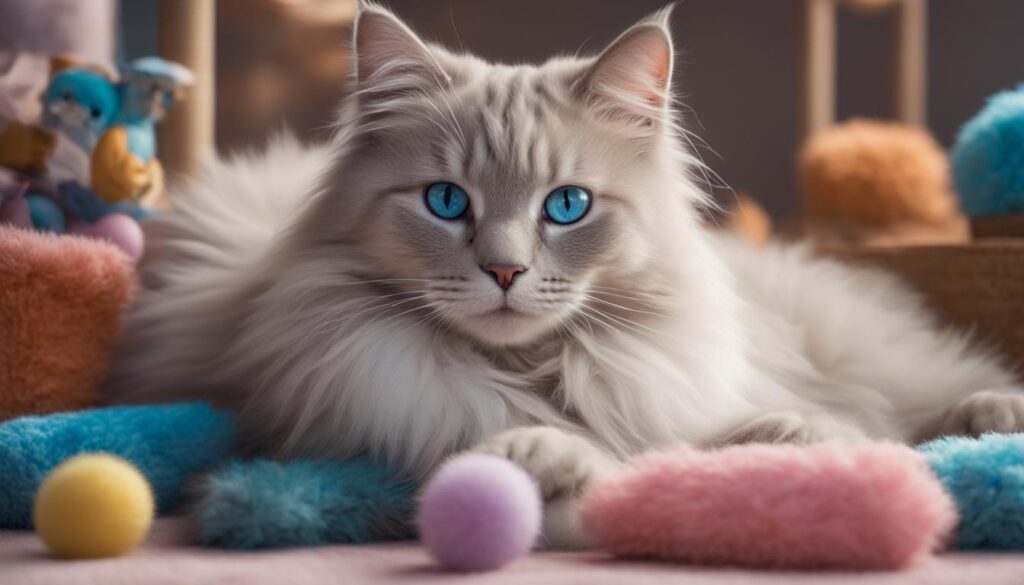What is a Ragdoll Cat?
What is a Ragdoll Cat? Are you looking for a friendly feline companion with a level temperament? Look no further than the Ragdoll cat! This cat breed is known for its charming personality and exquisite appearance. In this article, we’ll answer the question of what is a ragdoll cat, including interesting information about the breed and key characteristics that set this affectionate cat apart from other cat breeds. Ragdoll cats are a distinctive breed known for their blue eyes and soft, plush coats. They are a relatively new breed, first developed in the 1960s by the breeder Ann Baker. Since then, These floppy cats have become increasingly popular due to their sweet, laid-back personalities and gorgeous looks. One unique feature of Ragdoll cats is their tendency to go limp and relax when picked up, hence their name. They are also known for their love of human company and will often follow their owners around the house. If you’re considering getting a Ragdoll cat, it’s important to note that they are a large breed, typically weighing between 10-20 pounds. Ragdoll coats and colors can vary widely, from the classic pointed coloring to mitted and bicolor patterns. Ragdoll cats make wonderful pets for families and individuals alike. Their gentle disposition and stunning appearance are sure to win over any cat lover. The Charm of Ragdoll Cats There’s no doubt that Ragdoll Cats are one of the most charming breeds out there. This docile breed of feline is known for its laid-back personality and affectionate nature, making them wonderful companions and good house cats. But what exactly sets Ragdoll Cats apart from other breeds? For one, their personality is truly unique. Ragdoll Cats are often described as “puppy-like” due to their friendly and sociable behavior and dog-like personality. Ragdolls prefer spending time with their humans and often follow them around the house, seeking attention and affection. Unlike some other cuddly cat breeds, Ragdoll Cats are generally not aloof or independent. Instead, they crave human company and often curl up in their owner’s lap for a nap. Another charming aspect of Ragdoll Cats is their beauty. These cats come in a variety of colors and patterns, ranging from seal point and seal mitted to blue mitted ragdolls. Their lustrous coats are soft to the touch, making them a pleasure to pet and snuggle up to. Ragdoll Cats are also known for their large size, with males often weighing in at around 20 pounds. This makes them a striking presence in any home. If you’re considering adding a Ragdoll Cat to your family, it’s important to note that their charm does come with some specific care requirements. These cats should be indoor-only cats. They need regular grooming to keep their coats looking healthy and benefit from daily playtime and exercise. Additionally, Ragdoll Cats may be prone to certain health issues, such as hypertrophic cardiomyopathy or bladder stones, so it’s important to have regular check-ups with a trusted veterinarian. “Ragdoll Cats are often described as “puppy-like” due to their friendly and sociable behavior.” The charm of Ragdoll Cats lies in their unique combination of personality, beauty, and affection. These cats truly make wonderful pets for those looking for a loyal and loving companion. Distinctive Features of The Ragdoll Breed Ragdoll Cats are known for their striking appearance, which is a testament to their unique physical characteristics. From their size and weight to their coat colors and patterns, here’s a look at what makes Ragdoll Cats so distinctive: Ragdoll Cat Size Ragdoll Cats are one of the largest domestic cat breeds, with male cats weighing 12-20 pounds and females weighing 10-15 pounds. Their large size but gentle nature makes them a favorite among cat lovers and pet parents. Ragdoll Cat Colors and Patterns Coat Color Pattern Seal Pointed Blue Pointed Lilac Pointed Chocolate Pointed Red Mitted or Bicolor Cream Mitted or Bicolor Ragdoll Cats have a distinctive pointed coat pattern, meaning their body is lighter than their face, legs, tail, and ears. There are four common coat colors: seal, blue, lilac, and chocolate. Additionally, Ragdoll Cats can have patterns including Mitted, Bicolor, and Lynx. Ragdoll Cat Coat The Ragdoll Cat’s coat is medium to long in length, soft to the touch, and requires frequent grooming. They have a dense, plush coat that comes in a variety of colors and patterns, with a lighter-colored body and darker face, legs, and tail. Caring for a Ragdoll Cat Ragdoll cats have specific care needs that are crucial for ensuring their health and well-being. Proper care can help prevent health issues and ensure a long and happy life for your furry friend. Feeding Requirements It’s important to feed your Ragdoll cat a balanced and nutritious diet to maintain a healthy weight and reduce concerns like dental disease. Choose high-quality wet cat food that is free from artificial colors, flavors, and preservatives. Feed your cat at regular intervals and ensure they have access to fresh water at all times. Dry and wet food are not equal. Feeding your cat wet food has been proven by veterinary medicine to keep your cat more healthy. Grooming Needs Ragdoll cats have a long and beautiful coat that requires regular grooming to prevent matting and tangling. Brush or dematte your cat’s fur twice a week to remove loose hair and distribute natural oils throughout the coat. Use a wide-toothed comb to work out any tangles or mats. Trim your cat’s nails regularly to prevent them from becoming overgrown. Exercise Requirements Ragdoll cats are a fairly active breed and require regular exercise to stay healthy. Play fetch with your cat daily using toys like feather wands or balls. Encourage your cat to climb and jump by providing cat trees or perches around your home. Medical Care Regular veterinary checkups are essential for maintaining the health of your Ragdoll cat. Schedule annual checkups and vaccinations to keep your cat protected against common illnesses. Watch out for any changes in your cat’s behavior or health, such as lethargy
What is a Ragdoll Cat? Read More »

